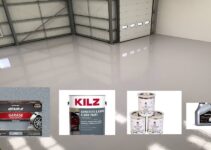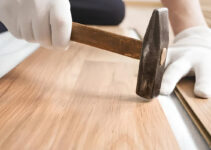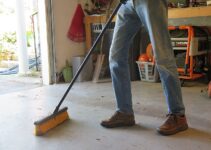Epoxy flooring has earned its reputation as a go-to solution for surfaces seeking durability, moisture protection, and easy maintenance.
When it comes to applying epoxy over wood, the complexity of the decision-making process increases significantly, demanding meticulous consideration.
In this article, Iwill delve deep into the nuances of opting for epoxy flooring over wood, providing valuable insights to empower you in making an informed decision.
Pros of Epoxy Flooring Over Wood
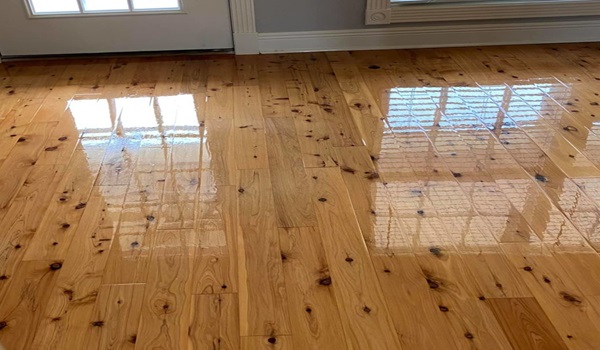
1. Durability
Epoxy doesn’t just create a surface; it forges a shield against the daily wear and tear. It stands resilient against scratches, stains, abrasions, and chemicals, promising to significantly extend the life of your beloved wood floor.
2. Moisture Protection
Beyond durability, epoxy acts as a safeguard, forming a waterproof barrier that shields your wood from the potential damages inflicted by moisture. This protective layer not only preserves the wood but also prevents the unwelcome growth of mold and mildew.
3. Easy Cleaning
The smooth, non-porous surface of epoxy transforms cleaning into a hassle-free task. Effortless maintenance becomes the norm, requiring minimal effort to maintain that pristine appearance that epoxy is known for.
4. Customizability
Epoxy doesn’t just offer protection; it provides a canvas for your creativity. With a spectrum of colors and decorative options like flakes or metallic pigments, you have the freedom to craft a floor that reflects your unique style and personality.
5. Improved Appearance
Is your wood floor showing signs of age or wear? Epoxy comes to the rescue, enhancing the aesthetic appeal by concealing imperfections and introducing a glossy, modern finish. It’s a transformative touch that breathes new life into your living space.
Cons of Epoxy Flooring Over Wood
1. Adhesion Issues
The marriage of epoxy and wood requires a perfect match. Adhesion issues, influenced by factors like wood type, existing finishes, and moisture content, can lead to unpleasant consequences such as peeling, flaking, and cracking of the epoxy.
2. Breathability
Wood, unlike other materials, needs to breathe. Epoxy, unfortunately, creates a barrier that inhibits this natural process, potentially causing moisture buildup and the onset of wood rot over time.
3. Difficult Removal
Once epoxy takes its place, it becomes a commitment. The removal process is not only challenging but also expensive, limiting your flexibility in changing your flooring choices in the future.
4. Cost
While epoxy offers a plethora of benefits, it comes at a cost—literally. Comparatively, epoxy flooring tends to be pricier than other wood finishing options like polyurethane or staining.
5. Application Complexity
Epoxy is not for the faint-hearted DIY enthusiasts. It demands meticulous preparation, skilled labor, and specific environmental conditions, turning the application process into a challenging project.
6. Unnatural Appearance
While glossy and modern may be the epitome of style for some, the same cannot be said for all wood floor enthusiasts. Epoxy’s unnatural appearance might not align with those seeking a more natural or rustic aesthetic.
Considerations Before Applying Epoxy Over Wood
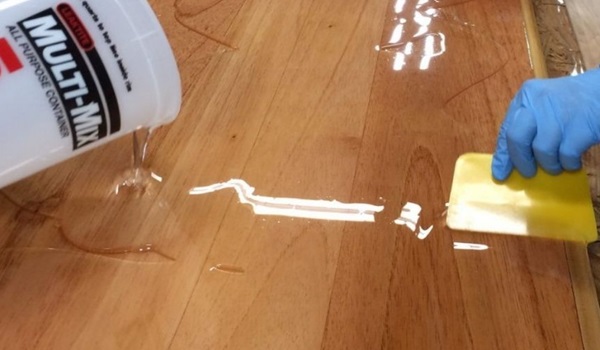
1. Wood Floor Condition
Before embarking on the journey of applying epoxy over wood, it’s imperative to evaluate the current condition of your wood floor. Ensure that it’s not just in a passable state but in genuinely good condition, free from major damages.
Any existing imperfections or flaws could compromise the adhesion of the epoxy, affecting its overall performance. Additionally, it’s advisable to have the wood floor recently refinished, providing an optimal canvas for the epoxy to adhere seamlessly.
2. Wood Type
Wood is a diverse material, with various species offering distinct characteristics. Unfortunately, epoxy isn’t a one-size-fits-all solution for all wood types. Certain species, especially softwoods or those with high moisture content, may pose challenges when paired with epoxy.
These challenges can manifest as adhesion issues, potentially leading to problems like peeling or cracking. Therefore, it’s crucial to identify the specific type of wood you have and understand its compatibility with epoxy before proceeding.
3. Moisture Level
Epoxy application demands a delicate balance in the moisture content of the wood. Before diving into the process, it’s essential to assess and adjust the wood’s moisture level to meet the specific requirements for successful epoxy application.
Excessive moisture can interfere with adhesion and compromise the longevity of the epoxy finish. Conversely, insufficient moisture might lead to a poor bond between the epoxy and the wood. Careful monitoring and adjustment ensure a stable foundation for the epoxy, promoting a lasting and effective result.
4. Traffic Level
The suitability of epoxy flooring is closely tied to the expected traffic levels in the designated area. While epoxy is renowned for excelling in high-traffic spaces, it might be an unnecessary investment for low-traffic rooms. Consider the practicality based on the room’s usage patterns.
High-traffic areas benefit most from epoxy’s durability, whereas in low-traffic rooms, alternative flooring options might be more cost-effective without compromising aesthetic appeal.
5. Desired Appearance
Aesthetic considerations play a pivotal role in the decision to apply epoxy over wood. Take a moment to envision the desired appearance of the space. Does the modern, glossy look of epoxy align with your vision for the room?
While epoxy offers durability and protection, it also introduces a specific aesthetic that may not suit every taste. Balancing functionality with your aesthetic goals is key to ensuring satisfaction with the final result. Consider whether the sleek, contemporary finish of epoxy complements the overall design and ambiance you wish to create.
Conclusion
Choosing epoxy flooring over wood is a multifaceted decision that transcends the surface-level benefits. While the allure of durability, moisture protection, and customizable appearances is strong, it’s crucial to weigh these advantages against potential drawbacks.
Adhesion concerns, breathability issues, and the complexity of application should be carefully pondered. Your wood floor’s condition, type, moisture levels, traffic patterns, and desired aesthetic play pivotal roles in shaping your decision-making process. So, approach this decision with diligence, and may your choice be as enduring as the floor you envision.
FAQs
Can epoxy be applied to any type of wood?
Epoxy is best suited for certain wood types, and compatibility depends on factors like wood species and moisture content. Softwoods and highly moisture-prone woods may present adhesion challenges.
Is epoxy removal really difficult?
Yes, removing epoxy is a complex and costly process. It is advisable to carefully consider this factor before committing to epoxy flooring.
Can epoxy be applied as a DIY project?
While some may attempt a DIY epoxy application, it is recommended to hire skilled professionals due to the complexity of the process.
What is the ideal moisture content for epoxy application?
The wood’s moisture content should fall within a specific range for successful epoxy application, ensuring optimal adhesion and performance.
Is epoxy suitable for all aesthetic preferences?
Epoxy’s glossy, modern appearance may not align with every aesthetic preference, particularly those favoring a natural or rustic look.
